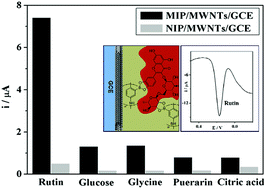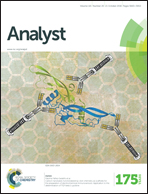Boronic acid based imprinted electrochemical sensor for rutin recognition and detection†
Abstract
Multi-walled carbon nanotubes (MWNTs) and boronic acid based molecular imprinting polymer (MIP) were successively modified on a glassy carbon electrode surface to fabricate a novel electrochemical sensor for rutin recognition and detection. 3-Aminophenylboronic acid (APBA) was chosen as a monomer for the electropolymerization of MIP film in the presence of rutin. In addition to the imprinted cavities in MIP film to complement the template molecule in shape and functional groups, the high affinity between the boronic acid group of APBA and vicinal diols of rutin also enhanced the selectivity of the sensor, which made the sensor display a good selectivity to rutin. Moreover, the modified MWNTs improved the sensitivity of the sensor for rutin detection. The mole ratios of rutin and APBA, electropolymerized scan cycles and rates, and pH value of the detection solution were optimized. Under optimal conditions, the sensor was used to detect rutin in a linear range from 4.0 × 10−7 to 1.0 × 10−5 mol L−1 with a detection limit of 1.1 × 10−7 mol L−1. The sensor has also been applied to assay rutin in tablets with satisfactory results.


 Please wait while we load your content...
Please wait while we load your content...